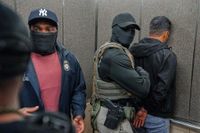On a quiet Saturday morning in San Bernardino County, east of Los Angeles, what began as a routine immigration stop quickly escalated into a flashpoint in the ongoing national debate over immigration enforcement and sanctuary policies. Just before 9 a.m. on August 16, 2025, federal agents conducting a targeted enforcement operation approached a vehicle, setting off a chain of events that would draw in local police, federal authorities, and a concerned community, while reigniting controversy over California’s sanctuary laws.
According to the Department of Homeland Security (DHS), the incident unfolded when the driver of the vehicle—later identified by advocates as a 43-year-old man from Mexico who has lived in the United States for 23 years without legal status—refused to roll down his window when instructed by federal agents. The agents, who were part of a U.S. Customs and Border Protection (CBP) team, were wearing uniforms with “police” emblazoned on their vests and at least one wore a hat labeled CBP. The man’s 18-year-old son and 23-year-old son-in-law, both U.S. citizens, were also in the car.
The situation escalated rapidly. Video footage, captured by the son and son-in-law, shows the masked agents approaching the vehicle and instructing the driver to lower his window. The driver resists, and one of the passengers asks, “What do you want?” The officers then smash the windows on both sides of the vehicle. In a moment of panic, the driver speeds away. Three gunshots ring out—one agent, claiming self-defense, fires at the fleeing car after, according to DHS, the driver struck two agents with his vehicle. Fortunately, no one was hit by the bullets.
The video, widely circulated in the aftermath, does not show either officer being struck by the car. DHS has not provided further details on the nature or extent of any injuries to the agents, nor have they clarified why the man was targeted for enforcement. The lack of transparency has fueled questions and concern among immigrant rights advocates and local residents alike.
Javier Hernandez, executive director of the Inland Coalition for Immigrant Justice, spoke with the family and relayed their account to the press. The family, whose members declined direct interviews, described the terror of the encounter and the confusion that followed. The driver, shaken, called the San Bernardino Police Department to report that masked men had pulled him over, broken his car window, and shot at him. Responding officers visited the family’s home, spoke with the driver, but—citing California law—did not take him into custody. As the department explained, state law prohibits local police from assisting federal officials with immigration enforcement.
This gap between state and federal authority quickly became the crux of the controversy. Federal agents later appeared at the family’s home, but the family, aware of their rights, refused entry because the agents did not present a warrant. As word spread, a crowd gathered outside the house, wary of the authorities’ intentions and determined to witness what might unfold. San Bernardino police returned, this time to manage the growing crowd.
DHS, for its part, publicly criticized the local police for not arresting the man. In a strongly worded statement, the department said, “This reckless decision came despite the subject’s outright refusal to comply and his wounding of two federal officers. It is yet another tragic example of California’s pro-sanctuary policies that shield criminals instead of protecting communities.” The language reflected ongoing tensions between federal agencies and California, a state that has long positioned itself as a sanctuary for immigrants, placing limits on local cooperation with federal enforcement efforts.
The term “sanctuary jurisdiction” itself lacks a precise legal definition, but it generally refers to state and local governments that restrict their involvement in federal immigration enforcement. California’s policies, codified in state law, have made it a focal point for federal crackdowns, particularly under the Trump administration. According to The Guardian, the administration’s aggressive approach has led to widespread raids across Southern California, sparking protests and, at times, the deployment of the National Guard and Marines in Los Angeles for nearly two months—a rare and dramatic show of force in a major American city.
The confrontation in San Bernardino is just one in a series of incidents that have heightened anxieties in immigrant communities. Earlier this month, federal raids in Los Angeles County resulted in the tragic death of a man who was struck by a vehicle as he tried to flee immigration officers. Reports have surfaced of border patrol agents using rental trucks to ambush individuals, employing excessive force, and making violent arrests. Many arrestees have reported injuries during these operations, further fueling criticism from advocates and local officials.
Legal battles have also intensified. After an appeals court upheld a temporary order by a district court judge banning indiscriminate immigration stops and arrests, the Trump administration filed an emergency petition with the Supreme Court, seeking to lift the restrictions. The U.S. Justice Department has published lists of states, cities, and counties—California among them—that it claims “impede enforcement of federal immigration laws,” vowing to challenge these policies through litigation.
For the family at the center of the San Bernardino incident, the ordeal has left them shaken and wary. With two U.S. citizen family members and a patriarch who has lived in the country for over two decades, their story highlights the complex realities faced by mixed-status families. Their experience, captured on video and amplified by advocacy groups, has become a rallying point for those who argue that federal enforcement tactics are increasingly aggressive and sometimes reckless.
Local officials, meanwhile, find themselves caught between state laws designed to protect immigrant communities and federal demands for cooperation. As Hernandez pointed out, the fear and uncertainty generated by such incidents ripple through neighborhoods, discouraging people from reporting crimes or cooperating with authorities, and undermining trust in public institutions.
As the legal and political battles over sanctuary policies and immigration enforcement continue, the events in San Bernardino serve as a microcosm of the larger national debate—one where the lines between law enforcement, civil rights, and community safety are often blurred. The outcome of the administration’s Supreme Court petition, and the ongoing push-and-pull between state and federal authorities, will likely shape the future of immigration policy not just in California, but across the country.
For now, the family at the center of the storm remains at home, surrounded by supporters and under the watchful eye of both local and federal authorities—a stark reminder of the human cost at the heart of America’s immigration debate.


